MENUMENU
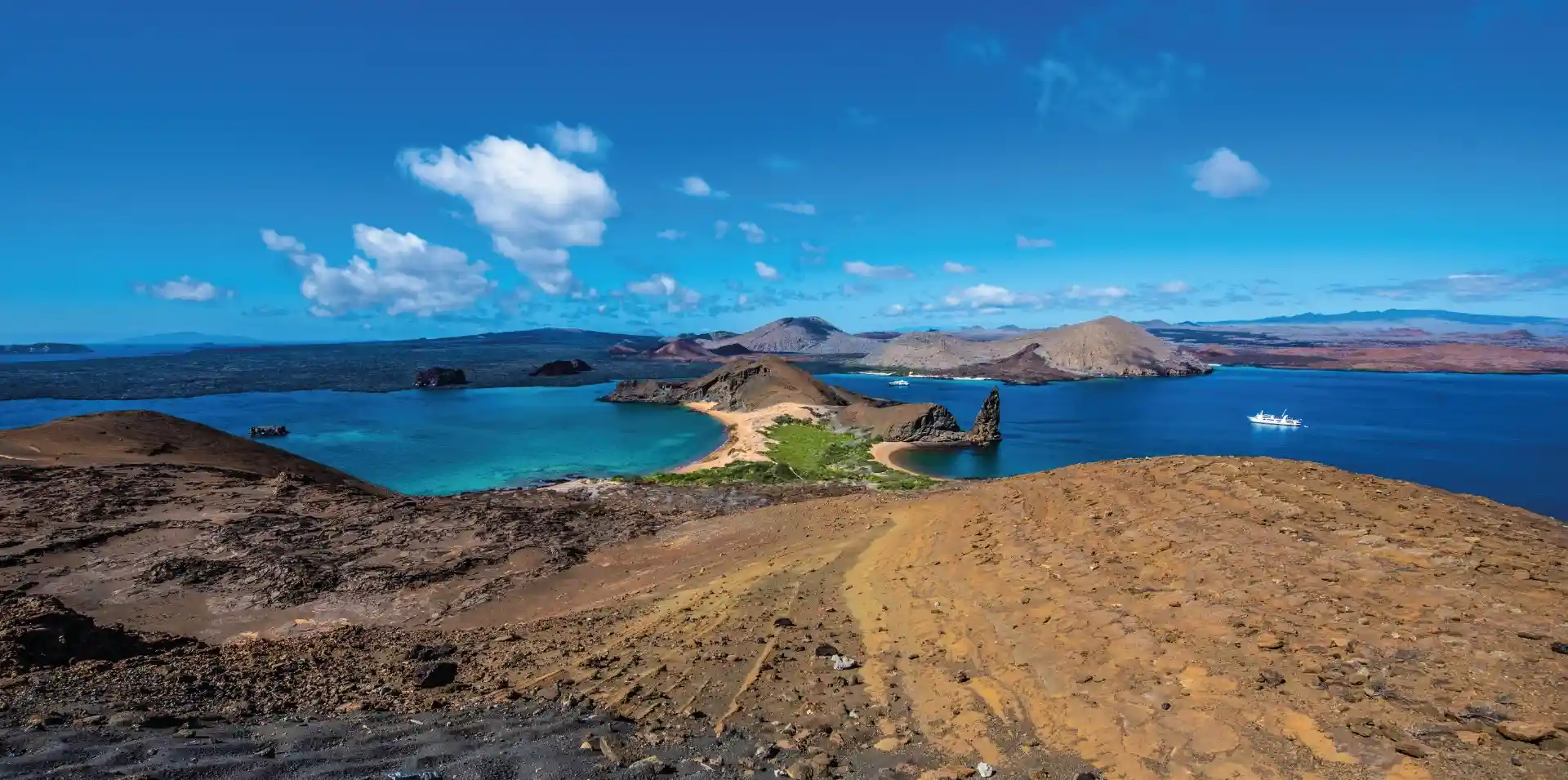
Reading time: 18 mins
When traveling to the best South American countries to visit, we want to know the whens, the whys, the hows, and the whats before we travel so that we can be as prepared as possible. In this article, we have gathered all of the information you’ll ever need to know before traveling to the Galapagos Islands and Ecuador.
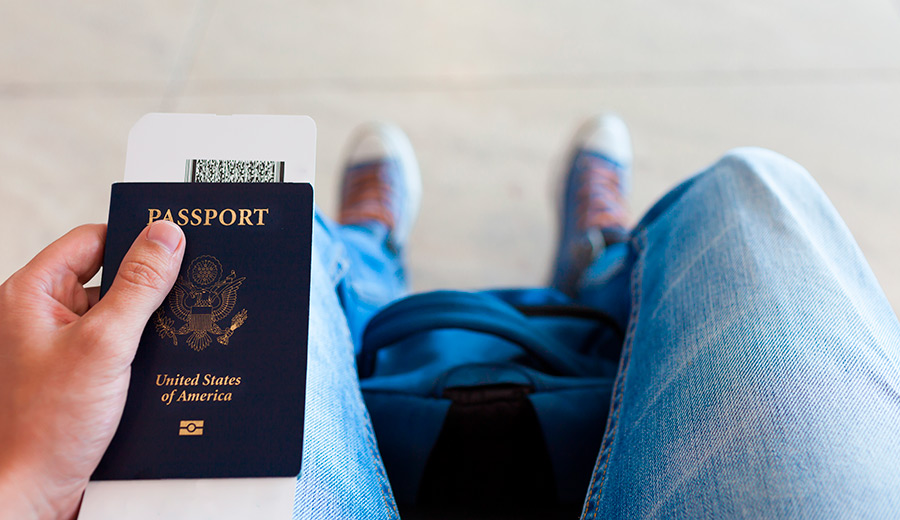
Make sure you have all your essential documents handy at the airport!
If you are only traveling as a tourist, then the answer is no! As you go through Ecuadorian customs in the airport, you will receive a free 90-day tourist permit. Just make sure that your passport is valid (more on that below), and you can enjoy three months in this beautiful country!
If you plan on visiting Ecuador, then it’s highly important that you check and make sure that your passport is still valid for at least six months (136 days) after your departure date from Ecuador.
For example, if you are coming into Ecuador on the 1st of January and leaving on the 7th of January, then your passport must still be valid six months after the 7th of January. Otherwise, you risk not being able to enter Ecuador, so be extra careful!
If you want to double-check that your passport will be accepted, you can always consult with one of our Destination Experts. There’s nothing worse than arriving in a country and being told you have to turn right back around and leave.
As well as passport validity, we suggest you make copies of all of your important documents including your credit cards, driver’s license, and passport, and leave your original passport in the safe at your hotel whenever possible. Always keep a passport copy on you at all times to have proof of identity.
Like many Latin American countries, Ecuadorian officials occasionally ask for proof of onward travel to try to stem illegal immigration. Depending on the day, you may or may not be asked by the airline or customs officers for proof. Often, this responsibility is passed onto the airline before you board your flight to Ecuador. To avoid disappointment, check with your airline before your trip to make sure you have the necessary documentation.
However, travel to the Galapagos Islands is much stricter. You must show a paid return flight out of the Galapagos Islands as stipulated by the Galapagos Transit Control Card (TCC/INGALA) authorities. Your time in the Galapagos is included in your Ecuadorian 90-day tourist visa, so don’t be caught out!

Travel insurance for trips to Ecuador
Currently, this is not a requirement, although it may become law in the future for every tourist visiting Ecuador. However, if you intend to spend more than a week in Ecuador, we strongly recommend acquiring travel insurance.
The short answer is no.
However, if you are traveling from Brazil, Angola, the Democratic Republic of Congo or Uganda, you will need to show certified proof of your Yellow Fever vaccination. Keep in mind that you must have this proof even if you were just passing through (aka. had a layover) in these countries.
If you want to share the information we’ve provided you with, feel free to download our brochures and pass them along! We hope they serve as the source of inspiration for many adventurous explorers like you.
Although the quality of the Ecuadorian tap water is generally okay, the chemical content and pipes that the water travels through often aren’t as reliable. Therefore, as a general rule, you should always drink bottled water to avoid any problems. Filtered, sparkling, or regular water is readily available at every shop, supermarket, hotel, Galapagos cruise ship, and expedition lodge, so don’t worry- you won’t go thirsty! In the case of the latter two, these often provide you with your own reusable water bottle upon arrival. In case you’re feeling thirsty and want to savor something a little more local, Ecuadorian beers (Club or Pilsener) are quite good, and popular bottled soft drinks are also available. Additionally, on any Metrojourneys tour where food or drink is provided, the freshly prepared drinks and raw vegetables are perfectly safe (and delicious) to eat.
The aptly named “Ecuador” lies directly on the equator, meaning that it is one of the closest countries to the sun. Combine that with high- altitude cities, and you’re in for a scorcher! We can easily be deceived by an overcast day or a cool breeze, but the UV rays can even penetrate the clouds and leave you longing for the sunscreen that you left behind. To avoid the discomfort of severe sunburn, we recommend you always use a sunscreen with at least 30+SPF and wear wide-brimmed hats and sunglasses for extra protection.

Ecuador’s official currency is the United States Dollar
If you travel to the USA often or live there, there’s good news for you! Ecuador’s official currency is the US Dollar. In 1999, the country changed from the Ecuadorian Sucre as the country suffered an economic crisis. However, keep in mind that although we share a common currency, things may be a bit cheaper here, so do try and bring smaller bills (avoid $50 and $100 bills, use $20 bills or lower, instead), as change is sometimes unavailable for bigger bills, especially in the smaller towns and villages you might explore.
Although you should keep in mind that small shops and taxis will only accept cash, most restaurants, shops, and hotels accept Visa, MasterCard, Diners Club, and American Express. All services provided by Metrojourneys, including our Galapagos cruise ships and programs, can be paid with major credit cards. Traveler’s Checks, on the other hand, are rarely accepted in the country.
General bank hours in Ecuador are from 9:00 a.m. to 5:00 p.m. Monday to Friday. Some larger cash exchange facilities and banks are open on Saturday morning, but hours vary. ATMs for all Ecuadorian banks are readily found throughout the larger cities. It’s advisable to carry cash in more rural areas, and you can make cash advances in most banks and ATMs. In the case of the Galapagos, there are ATMs in the major towns (Puerto Ayora and Puerto Baquerizo Moreno).
In general, the taxi fare from Quito’s international airport to the Historic Center is around $25 USD. Usually, a fare will never exceed $5 when taking a taxi throughout Quito, but this price may vary in other major Ecuadorian cities. To ensure you get a competitive price, it’s best to allow your hotel or restaurant to call you a taxi or use a trusted application such as Cabify or Uber. Make sure you carry small bills or change on you to pay the taxi driver.
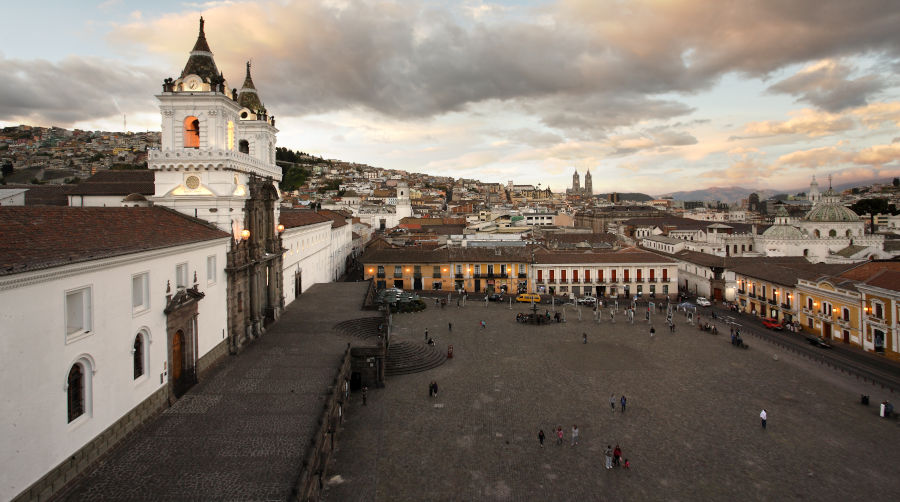
San Francisco plaza during the evening time in Quito, Ecuador
Whether tipping is expected in Ecuador depends on the establishment. In restaurants, a 10% service charge is often included in your bill. Of course, an extra 5% will be received gratefully if the service was superb. The general rule of thumb for bellboys is about US$1 per bag and US$1 per day for chambermaids. Remember that 10% is already charged to your bill for room service. We do not tip taxi drivers in Ecuador.
In Ecuador, the sales tax of 12% is already added to all purchases and a service tip of 10% is usually added to hotel and restaurant bills. Another thing to remember is that in Quito there is a small city hotel tax that will be included in your bill.
Ecuador has two languages that are spoken widely. The official language is Spanish, but the native population generally speaks different dialects of Kichwa, which is the main language of the ancient Incans. Smaller tribes speak other languages in certain regions of the country, but nearly everyone speaks Spanish.
But don’t worry if you only speak English! At touristic sites and major cities throughout Ecuador, a large percentage of the population speaks enough English to be able to help you. However, if you’re not comfortable with that, rest assured that if you book a tour through us our guides and service staff will be more than happy to convey any instructions and information to you in English (or other major languages)!
Mainland Ecuador is GMT/UCT minus 5 hours, but remember that the Galapagos Islands are one hour behind at GMT/UCT minus 6 hours.
The main religion in Ecuador is Roman Catholic. However, there are a variety of other denominations, and citizens have the freedom to practice the religion of their choosing.
For most outlets 110 volts, 60 cycles AC is used. All of the outlets are two flat prongs, and many outlets are also designed for three–prong plugs – the same outlet type as North America. You should invest in an outlet adaptor if you are coming from a country that uses a different type of plug or voltage.
As Ecuador sits directly on the equator, there aren’t any true seasons. Instead, the year is divided into a rainy season and a dry season. However, keep in mind that the weather differs greatly between the coast, highlands, the Galapagos Islands, and the Amazon due to proximity to the ocean or rainforest, and the altitude. The coast and the Amazon regions are generally warmer and more humid, whereas the highlands are cooler at night and sunny during the day.
In particular, Quito is generally like spring throughout the year because it can often jump from a sunny day to a cold and rainy one within a few minutes. You should always carry a raincoat or umbrella and wear layers to keep warm and dry.
Want to know more about the weather in Ecuador and Galapagos and when is the best time to go?
Whatever you do, you need to make sure that you are comfortable, and if you are traveling to multiple regions, you need to pack for the climate. In the highlands, dress in layers to ensure you will always be warm enough, and that way any cotton T-shirts you have can be worn at the beach or in the Amazon (cotton is best for warmer climates). You will also need a warm jacket for the evenings, which may get slightly cold. It’s also important to bring conservative clothing that covers your shoulders and legs when visiting churches, monasteries, or shrines. Don’t forget to bring comfortable, waterproof shoes that can be versatile over uneven cobblestones, Amazon forest floor, or rocky shores.
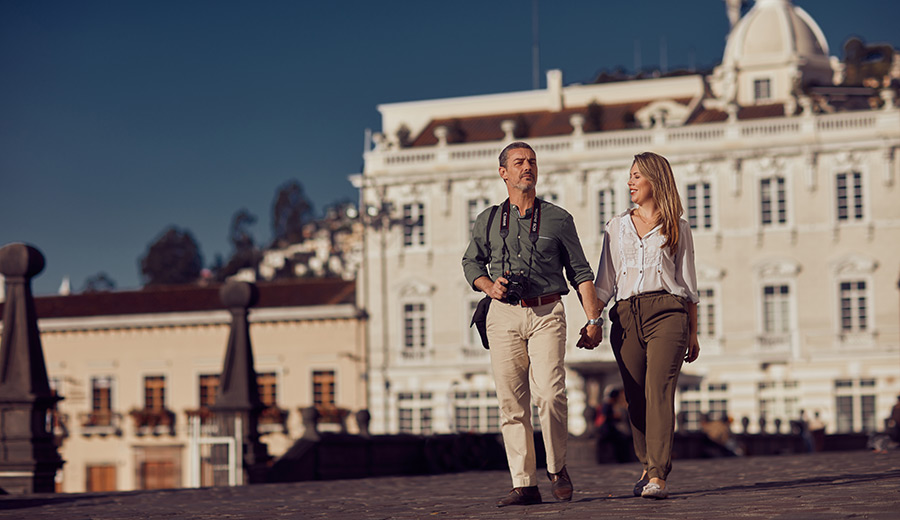
Couple walking on San Francisco Plaza in Quito, Ecuador
The minimum recommended time is about two weeks to make sure you experience the most important parts. We suggest you stay a minimum of 3 days in Quito and the highlands, three days in the rainforest or the cloud forest (such as Mashpi Lodge), and at least five days on the Galapagos Islands. This should provide you with just enough time to enjoy Ecuador’s incredible diversity.
Most importantly, you should consider staying in the Galapagos for as long as possible (without overstaying your 90-day tourist permit, of course!) Remember that traveling between destinations and visitor points takes time, and travel time between the Galapagos and Ecuador will take at least half a day. If you choose to explore the islands on an expedition vessel, your first day will include an activity, but the last day requires you to prepare yourself for departure. The more days you stay, the more likely you are to experience the entire beauty and uniqueness of the islands, including seeing a greater number of the Galapagos BIG15 species.
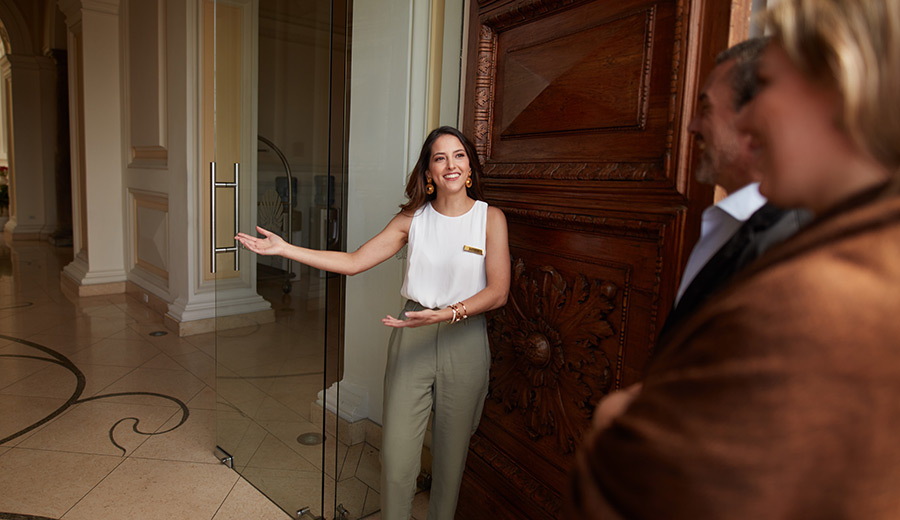
Casa Gangotena Boutique Hotel’s concierge greeting guests
Most Galapagos excursions and mainland activities are family-friendly, but it is recommended that kids at least six years old to properly enjoy travel Ecuador. The major hotels throughout Ecuador cater to children of all ages, from providing children’s menus to baby sitters and extra beds. Children over the age of six will have no problem on the mainland or throughout Galapagos excursions. We do not suggest you bring very young children (under the age of 6) on some of our tours, such as the Galapagos or other adventure-packed destinations.
Ecuador is generally a safe country, although common sense in looking after your belongings is always wise. Take care of your most valuable belongings and carry copies of your passport, credit cards, and any other important documents you may have with you, and leave the originals in the safe in your hotel. Keep cash (especially large bills) and anything of value out of sight, including any flashy jewelry, expensive cell phones, and cameras. For peace of mind, you could invest in a money belt that can be worn under your clothing, but keep small change in a separate purse for easy access. There’s nothing worse than whipping up your shirt to look for money in the middle of town! After dusk, it is better to get a hotel or restaurant to call a taxi or to order one from an App.
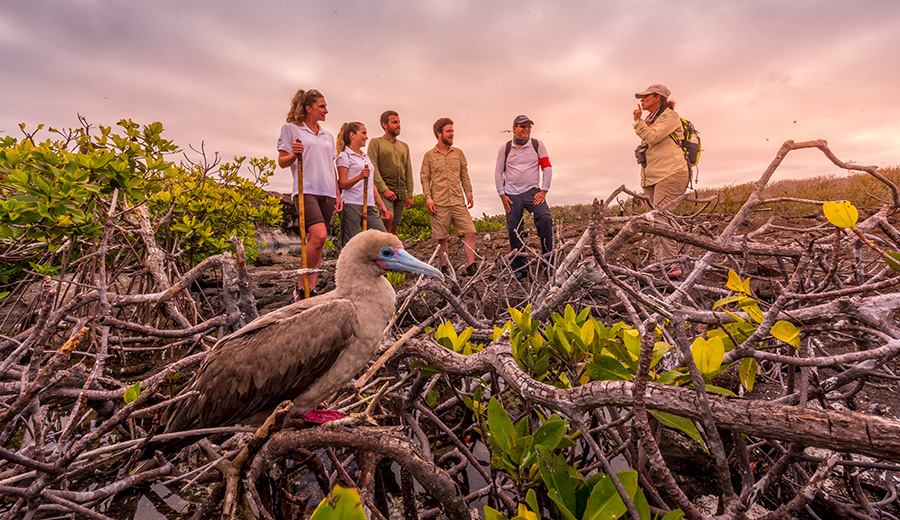
Expedition group with red-footed booby at Genovesa Island, Galapagos
Remember to bring proof of a return ticket out of the Galapagos Islands, as this is strictly monitored by the Galapagos Transit Control Card (TCC/INGALA) and immigration authorities. Also, remember that your time on the islands is included in your 90-day tourist visa.
Altogether the Islands cover an area of 7,900 square kilometers, which is about 3,040 square miles. To put it into perspective, that’s about the same size as the state of Mississippi or the country of Greece.
Galapagos is only accessible via airplane. Three airlines (TAME, Avianca, LATAM) fly from either Guayaquil or Quito to the two airports in the Galapagos (Seymour and San Cristobal). There are no international flights that go directly to the Galapagos.
The process of turning the Galapagos Islands into a tourist-friendly destination was done very, very carefully so as not to cause any negative environmental impact. Around 5% of the visitor sites have man-made trails made from dirt, wood or cement to make the walk a little easier. The majority of the walks, however, are over the natural contours of volcanic rocks, lava flats, gravel, sand, and even boulders that require a little bit of balance as you admire the scenery. This means the hikes range from easy to somewhat moderate. We do not recommend wearing your best stilettos on any Galapagos hike. So what shoes do we recommend? Keep on reading!
When we think about islands, we often think about tropical beaches, palm trees, and sandals, but this isn’t exactly the case with the Galapagos Islands. The islands have some incredibly rough terrain due to them being formed by volcanic activity. This creates a unique landscape that shouldn’t be attempted in ordinary sneakers. Instead, opt for rugged hiking shoes. At our Finch Bay Hotel and aboard our ships, we also offer walking sticks to guests, but the most important thing is to bring a good pair of comfortable hiking shoes with ankle support.
Good question! Have a look at our useful blog on what to wear for your Galapagos cruise right here!
Apart from the Tortuga Bay hike, which is a mile–and–a–half long, there aren’t any hikes longer than a mile. Surprise! They are measured in miles as the United States Department of the Interior supervised the design of the trails, making sure they were tourist-friendly.

Trekking at Bartolome Island, Galapagos
The beauty is that there’s never a bad time to visit the archipelago – it’s a year–round destination! The hot season is from January to June, which means the sun will be shining and the grass will be green. The dry season runs from June to December, which means the land is less green, but the ocean becomes a flurry of activity. If you have a particular animal you would like to see, look into the best time of year to see it and plan your visit around then! For example, if you want to see the mating ritual of the blue-footed booby, plan your visit between June and August. Check out our blog on the Best Time to Go to the Galapagos or ask our Destination Experts for more information!
Every itinerary has been created to suit a different group of people with different interests – there isn’t a “one size fits all” option. You should factor in how much time you have available along with what you want to see and do. If you’re unsure, feel free to talk to ask our Destination Experts about which itinerary is the best fit for you.
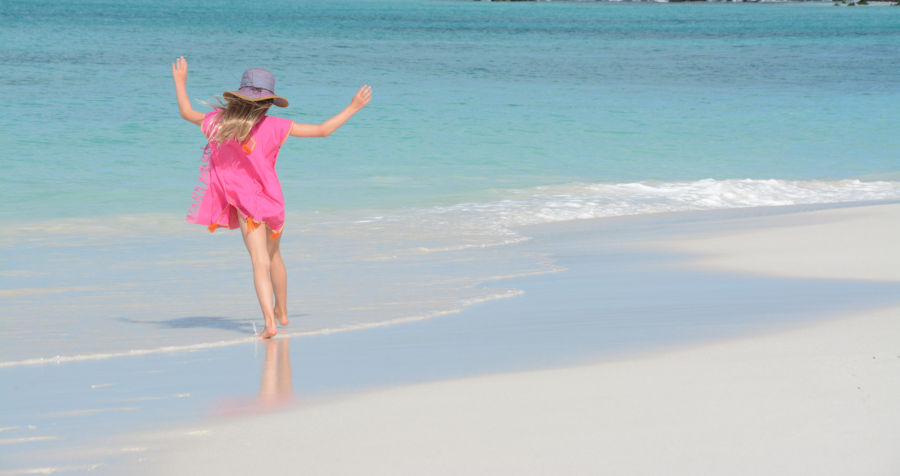
Girl having a fun time in the seaside, Galapagos
In general, the Galapagos Islands have very uneven surfaces due to their volcanic terrain and geography. Therefore, they aren’t suitable for those with significantly reduced mobility.
Unfortunately, our vessels do not have wheelchair access. Nor are they designed for those with highly reduced mobility as they aren’t equipped with elevators or ramps.
“Pupping months” are generally from August and September, right in the middle of the dry season, but some are born as late as October. If you are lucky, you might be able to see a sea lion giving birth!
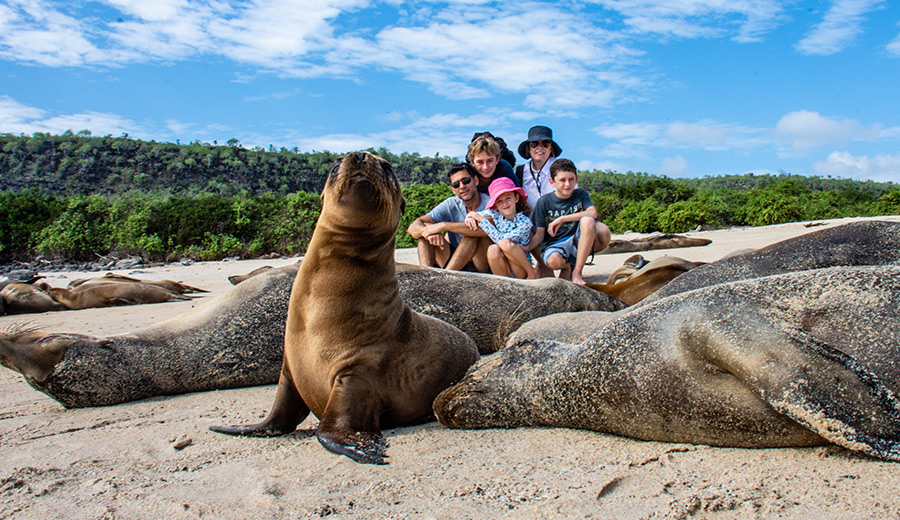
Family posing next to a Galapagos Sea Lion
Note:We strongly recommend that you plan your trip or book your tour before buying your plane tickets so you don’t have to travel long distances between islands on a speedboat or incur more expenses by having to board an interisland flight to align with your cruise schedule or the things you have planned for your trip.